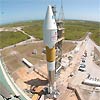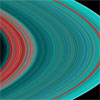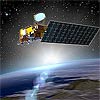|
Sunday:
July 11, 2004 | |
0033 GMT |
 |
Texas observatory finds its first extrasolar planet
McDonald Observatory astronomers have exploited the Hobby-Eberly Telescope's capabilities to rapidly find and confirm the giant telescope's first planet outside our solar system. The event serves as proof-of-concept that the telescope is on track to become a major player in the hunt for other worlds.
 FULL STORY FULL STORY
 |  |

|
 |
|
Saturday:
July 10, 2004 | |
0450 GMT |
 |
Atmospheric observatory launch postponed
Troubles with a connector on the Delta 2 rocket's nose cone have forced officials to postpone Sunday morning's attempt to launch the Aura spacecraft from Vandenberg Air Force Base, California.
 MISSION STATUS CENTER - updates! MISSION STATUS CENTER - updates!
 LAUNCH EVENTS TIMELINE LAUNCH EVENTS TIMELINE
 GROUND TRACK MAP GROUND TRACK MAP
 |  |

|
 |

Additional coverage for subscribers:
 VIDEO:
AURA SCIENTIST EXPLAINS WHAT MISSION AIMS TO DO QT VIDEO:
AURA SCIENTIST EXPLAINS WHAT MISSION AIMS TO DO QT
 VIDEO:
WATCH FRIDAY'S PRE-LAUNCH NEWS CONFERENCE QT VIDEO:
WATCH FRIDAY'S PRE-LAUNCH NEWS CONFERENCE QT
 VIDEO:
ANIMATION OF AURA STUDYING THE ATMOSPHERE QT VIDEO:
ANIMATION OF AURA STUDYING THE ATMOSPHERE QT
 VIDEO:
FLASHBACK TO THE AQUA LAUNCH IN 2002 QT VIDEO:
FLASHBACK TO THE AQUA LAUNCH IN 2002 QT
 SUBSCRIBE NOW SUBSCRIBE NOW

|
How to fail at being a star
Scientists have announced the discovery of a unique pair of newborn brown dwarfs in orbit around each other. Brown dwarfs are a relatively new class of objects discovered in the mid-1990s that are too small to ignite hydrogen fusion and shine as stars, yet too big to be considered planets.
 FULL STORY FULL STORY
 |  |

|
 |
|
Friday:
July 9, 2004 | |
0324 GMT |
 |
Space probes track blast wave through solar system
A fleet of spacecraft dispersed throughout the solar system gave the best picture to date of the effects of blast waves from solar storms as they propagate through the solar system.
 FULL STORY FULL STORY
 |  |

|
 |
Precautionary tests delay Atlas launch four weeks
Launch of a classified U.S. national security satellite aboard Lockheed Martin's final Atlas 2AS rocket is being retargeted for July 27 after a four-week delay to double-check a vital control unit on the booster.
 MISSION STATUS CENTER MISSION STATUS CENTER
 |  |

|
 |
OTHER HEADLINES Additional stories today
|
 |
Free Hubble home software now available -- For many years astronomical images from the world's telescopes were reserved for an elite of astronomers and technical people. Now anyone with a desktop computer running Adobe Photoshop software can try their hand at crafting astronomical images as beautiful as those from the Hubble Space Telescope.

Personnel named to NASA's new Science Mission Directorate -- Alphonso V. Diaz, who will assume leadership of NASA's new Science Mission Directorate as its Associate Administrator on Aug. 1, has named Orlando Figueroa Deputy Associate Administrator for Programs and Alison L. McNally Deputy Associate Administrator for Management in the directorate.
|
 |
|
Thursday:
July 8, 2004 | |
0612 GMT |
 |
Ultraviolet pictures hint at origin of Saturn's rings
The best view ever of Saturn's rings in the ultraviolet indicates there is more ice toward the outer part of the rings, hinting at ring origin and evolution, say two University of Colorado at Boulder researchers involved in the Cassini mission.
 FULL STORY FULL STORY
 |  |

|
 |
Glimpse at early universe reveals surprise
A rare glimpse back in time into the universe's early evolution has revealed something startling: mature, fully formed galaxies where scientists expected to discover little more than infants.
 FULL STORY FULL STORY
 |  |

|
 |
Launch of NASA environmental craft delayed
This weekend's liftoff of NASA's Aura atmospheric research satellite has slipped from Saturday to Sunday so technicians can sort through records to determine if any suspect transistors are installed in the spacecraft.
 MISSION STATUS CENTER MISSION STATUS CENTER
 |  |

|
 |

Additional coverage for subscribers:
 VIDEO:
ANIMATION OF AURA STUDYING THE ATMOSPHERE QT VIDEO:
ANIMATION OF AURA STUDYING THE ATMOSPHERE QT
 VIDEO:
FLASHBACK TO THE AQUA LAUNCH IN 2002 QT VIDEO:
FLASHBACK TO THE AQUA LAUNCH IN 2002 QT
 SUBSCRIBE NOW SUBSCRIBE NOW

|
|
Wednesday:
July 7, 2004 | |
0233 GMT |
 |
Chandra looks over a cosmic four-leaf clover
A careful analysis of observations by NASA's Chandra X-ray Observatory of a rare quadruple quasar has uncovered evidence that possibly a single star in a foreground galaxy magnified X-rays coming from the quasar. This discovery gives astronomers a new and extremely precise probe of the gas flow around the supermassive black hole that powers the quasar.
 FULL STORY FULL STORY
 |  |

|
 |
NASA using shuttle carrier aircraft for fuel-tank test
A Boeing 747 aircraft normally used to ferry space shuttles across the country has been pressed into service to test fuel inerting system technology to make airliners safer. The FAA and NASA have been working on technology to prevent fuel tank fires since the TWA Flight 800 accident.
 FULL STORY FULL STORY
 |  |

|
 |
Mapping the galaxy, and watching our backyard
One of the European Space Agency's most ambitious current projects has the aim of compiling the most precise map of one thousand million stars in our galaxy. Gaia, a spacecraft which will carry two of the most sensitive cameras ever made, is due to be launched in 2010.
 FULL STORY FULL STORY
 |  |

|
 |
|
Tuesday:
July 6, 2004 | |
0558 GMT |
 |
Investigators probe Sea Launch rocket anomaly
The Russian space company Energia and an independent board are investigating last week's early engine shutdown during a commercial Sea Launch rocket flight that left an Asian communications satellite 9,000 miles short of its planned orbit.
 FULL STORY FULL STORY
 |  |

|
 |
Is tranquil environment around Earth unusual?
Astronomers studying the Tau Ceti system have discovered that it contains ten times as much material in the form of asteroids and comets as our own solar system. Their discovery suggests that even though Tau Ceti is the nearest Sun-like star, any planets that may orbit it would not support life as we know it due to the inevitable large number of devastating collisions.
 FULL STORY FULL STORY
 |  |

|
 |
|
Monday:
July 5, 2004 | |
0316 GMT |
 |
New view of Orion Nebula's stellar nursery
Orion the Hunter is perhaps the best-known constellation in the sky, well placed in the winter for observers in both the northern and southern hemispheres, and instantly recognizable. Just below Orion's belt, the hilt of his sword holds a great jewel in the sky, the beautiful Orion Nebula.
 FULL STORY FULL STORY
 |  |

|
 |
NASA creates first 3-D view of solar eruptions
NASA-funded scientists have created the first three-dimensional view of massive solar eruptions called Coronal Mass Ejections. The result is critical for a complete understanding of CMEs, which, when directed at Earth, may disrupt radio communications, satellites and power systems.
 FULL STORY FULL STORY
 |  |

|
 |



